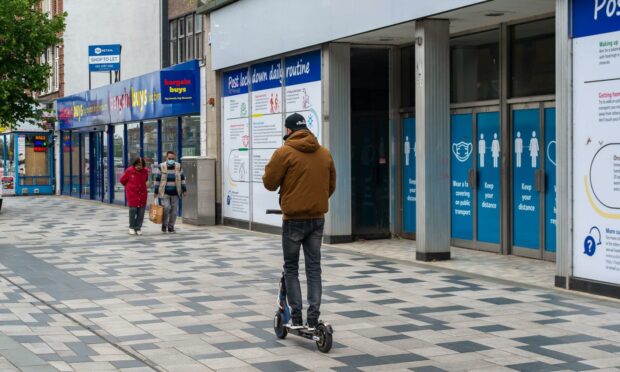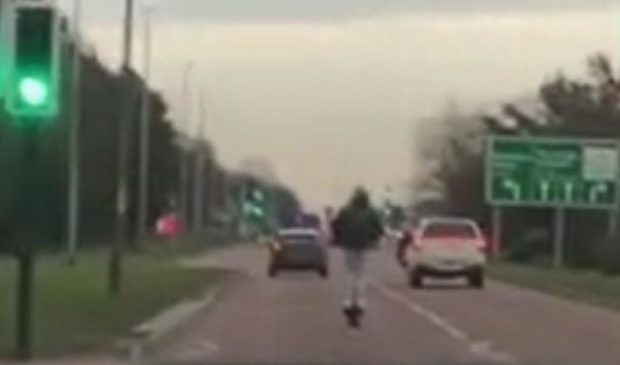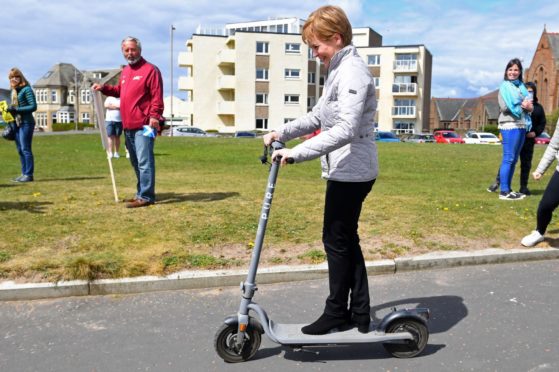Electric scooters have been involved in accidents recently and are increasing in popularity — but what are the rules around their use?
‘E-scooters’ are officially defined as motor vehicles and the most expensive models can reach speeds of up to 68mph.
Despite being illegal to use in public in Scotland, they are often seen ridden at surprising speeds on pavements and public areas.
And there have been various serious and minor crashes involving them, including in Tayside and Fife.
Just this week a man in Dundee was rushed to hospital after being struck by an e-scooter rider who did not stop to help.
Another rider was even seen on Dundee’s busy Kingsway bypass in March this year.
Why are they still on sale?
While they can be bought legally, they cannot be used in public spaces such as roads, pavements, parks, town centres or promenades.
They can still be used in a private setting but realistically, most people do not have such a space.
Police Scotland say the rules on their use are clear, despite even First Minister Nicola Sturgeon seemingly falling foul of the law when she was pictured on one.
If used in private, the user still needs insurance and a valid driving licence, and must comply with various construction and use requirements.
Anyone caught risks a £300 fine, six penalty points on their driving licence and an additional fine if they don’t have insurance.
In some areas of England, the vehicles can be rented for use in public as part of a trial but have a built-in speed limit of 15.5mph.
There is no such scheme currently in place in Scotland.
What are the concerns?
The speed of the vehicles is a big concern, coupled with the fact sales have almost doubled year-on-year.
Clearly most people buying an e-scooter will plan on using them in public despite it being illegal.
Debate on the dangers was first sparked when Youtuber Emily Hartridge died while riding one when she was thrown under a lorry in Battersea.
She is believed to be first person in the UK killed in a crash involving an e-scooter.
Since then, politicians have debated how to best control their use.
A UK Government parliamentary transport committee heard evidence from charities, experts, and campaigners.
One of the biggest concerns centres on claims they create ‘no go areas’ for people visually-impaired as well as wheelchair users and others vulnerable.
The Royal National Institute of Blind People (RNIB) have argued the max speed should be “as close to walking as possible”.
In trials in England, there are claims the e-scooters are being left abandoned too, causing a trip hazard.
Voi, which runs one of the schemes, say just like cyclists and pedestrians, e-scooter riders are “also vulnerable road users”.
They say e-scooters could contribute to reducing car use and with dedicated riding space, as well as parking infrastructure, the safety of their use will be further improved.
The UK Government has allowed the trials because it believes they could help reduce greenhouse gas emissions.
Why are they suddenly so popular?
The technology has existed for over a decade but they suddenly rose to prominence in 2018 when US cities, followed by hundreds of others across the globe, rolled out sharing schemes.
They are still relatively expensive to buy but with more manufacturers, budget options have been released.
It’s possible to buy a basic model for under £100, while the most snazzy brands can reach £6,000.
Many online retailers and stores in the UK offer popular brands for around £300.
Police Scotland is beginning to clamp down on public use of e-scooters, particularly because of the increase in popularity.


